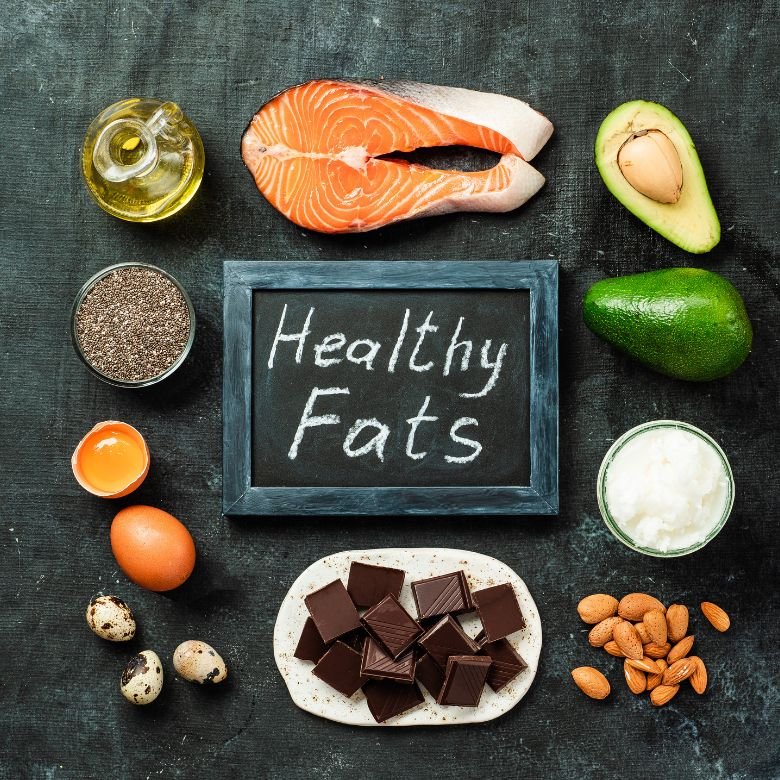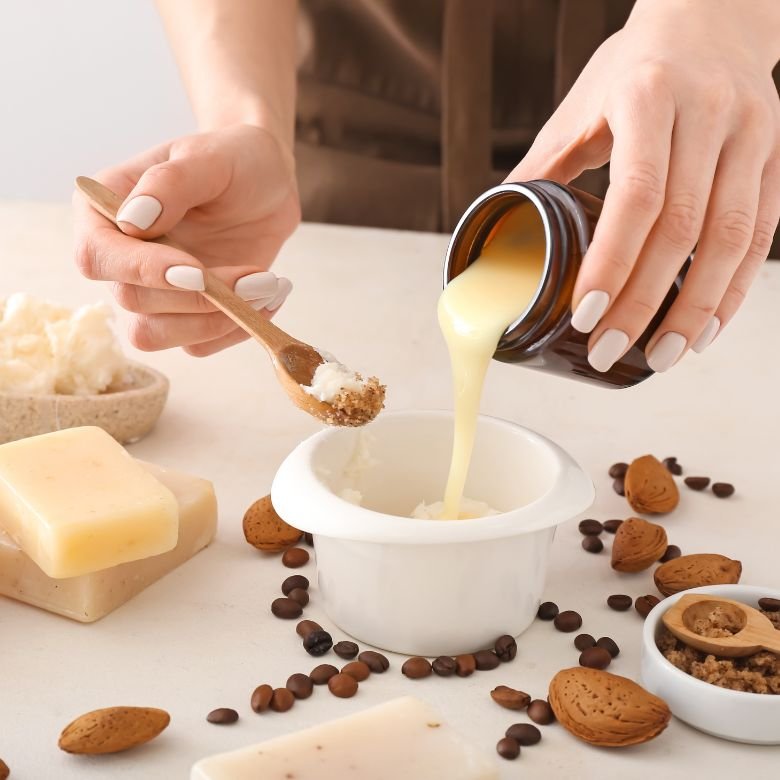In chemical terms, fats (also called glycerides) are mixtures of glycerol and long chain esters of carboxylic (fatty) acids containing 12 to 18 carbon atoms per molecule. A fat molecule may include acid radicals originating from different carboxylic acids. The whole group is classified as organic chemical compounds from the category of lipids. Since fats contain multiple bonds, we can divide them into saturated and unsaturated fats.

Classification of fats – examples
Fats can be divided based on their physical state, origin, and chemical nature. In terms of the physical state , a fat can be solid (e.g., coconut butter, lard or tallow) or liquid (soya bean oil, olive or fish oil). The physical state also suggests another division: the hydrocarbon part of solid fats only contains saturated bonds, while liquid fats also include unsaturated bonds. The presence of double bonds affects the flexion of the carbon chain, which in turn reduces the packing of molecules and thus also their density. Naturally occurring unsaturated fats feature the structural “–cis” geometry , but when subjected to heat treatment they transform into “–trans” isomers, which are harmful to human health. The chemical nature of fats may also vary in terms of the presence or absence of particular bonds in the structure. Saturated fats only contain saturated bonds, as in the case of lard, tallow or butter, whereas unsaturated bonds can be found in soya bean oil, olive, or fish oil. The third important classification is by origin: fats may derive from plants or animals.
The origin of fats
The most common lipids are animal fats and vegetable oils. Despite considerable differences in appearance and physical state, their structures are very similar. Animal fats are solid (e.g., butter or lard), while vegetable oils are liquid (such as maize oil or peanut oil). In terms of the structure and chemism of molecules, both the animal and vegetable fats are triacylglycerides (TAGs) – glycerol (glycerin) triesters with three molecules of long chain carboxylic acids. The highest quantities of vegetable fats are included in the seeds and pulp of fruit, whereas animal fats can be found mostly in cells and fatty tissues. Besides the two most important fat sources, there are also the artificially synthesized fats. Natural fats are entirely a mixture of many esters, while synthesized fats only consist of a single chemical compound.
Basic physico-chemical properties of fats
Although the representatives of that diversified group have different structures, none of them dissolves in water. However, they do dissolve in popular organic solvents such as benzene, diethyl ether, chloroform or acetone, due to their non-polar structure. Fats combined with water produce emulsions, that is non-uniform mixtures in which one liquid is dispersed in the other. Their density is lower than that of water, which is why they flow up to its surface. Their specific gravity is 0.910 to 0.996g/cm3. Fats go rancid, which means they produce chemical compounds harmful to the human body, such as butyric acid having an unpleasant taste and smell. The transformation occurs in aerobic conditions, under the influence of temperature and bacteria. In normal conditions, no matter the physical state, fats have no odour, taste or colour and show a neutral reaction. Any taste or odour may come from admixtures or decomposition products. Fats are non-volatile and flammable, with a lower heating value of around 38 J/g. Their net calorific value is approx. 39 kJ/g, so they constitute high-energy reserve materials. Fats are obtained by esterification, which occurs directly between the carboxylic acid and an alcohol. It is the basic reaction for simple and complex lipids, but not for isoprenoids. Esterification always occurs in an acidic environment and is reversible. It runs according to the following reaction:
R1COOH + R2OH ↔ R1COOR2 + H2O

Proper fats
In terms of structure, these are esters of trihydroxyl alcohol (glycerol) and different fatty acids. A glycerol molecule contains three esterifiable hydroxyl groups, so the reaction occurs between one, two or three groups (depending on the conditions) and the fatty acid. The products of such transformations can be monoacylglycerols, diacylglycerols and triacylglycerols, which contain one, two or three fatty acid radicals per molecule, respectively. All natural fats are triacylglycerols, while synthetic fats are usually monoacylglycerols or sometimes diacylglycerols. An example of proper fats is the glycerol tristearate, in whose molecule all the three hydroxyl groups are esterified by the molecules of stearic acid.
Complex fats
Complex fats are components of cell membranes which condition their proper functioning. Their role is usually to absorb shocks of internal organs and to provide thermal insulation. They are divided into three main groups: phospholipids, glycolipids and steroids. They can be distinguished by the presence of particular atoms in their molecules. Phospholipids are derivatives of phosphatidic acid, glycolipids contain sugar, and steroids are built of four adjacent aromatic rings.
Simple vs. mixed fats
Given the capabilities of the three acid radicals present in triacylglycerol, the structure may include three identical or different radicals of fatty acids. This is how we distinguish simple triacylglycerols, which contain the same acid radicals, and mixed triacylglycerols, having different acid radicals. In most cases, natural fats have several different acid radicals, so they are mixed fats. For this reason, they have their own isomerism, i.e. the arrangement of various groups in different locations contributes to the simultaneous presence of their three position isomers in nature. Therefore, the category of fats existing in nature is very extensive.
The hydrolysis of fats
The hydrolysis of fats is possible in two different variants. Water causes acid hydrolysis, while a basic environment results in alkaline hydrolysis. The acid hydrolysis produces glycerol and fatty acids. The alkaline hydrolysis is also referred to as saponification. As a result of that reaction, we obtain glycerol (propane-1,2,3-triol) and salts of fatty acids whose radicals were components of the fat subjected to the reaction. In chemical terms, the commonly known soaps are sodium or potassium salts of higher carboxylic acids, and usually their mixture, which is where the alternative name of the alkaline hydrolysis of fats (saponification) comes from. The mechanism of the acid hydrolysis of fats does not differ from the hydrolysis of esters. The process starts with the protonation of a carbonyl atom of oxygen with the aim to activate the molecule, which then causes the addition of a nucleophilic water molecule. The next step is thrtransformation of the proton and then the elimination of the alcohol molecule including the formation of carboxylic acid. At the final stage, the acidic catalyst is reproduced.
The saponification of fats
The mechanism itself is the one of nucleophilic substitution, where the nucleophilic agent is the hydroxide anion. In the initial stage, it connects to the carbon atom of the fat’s carbonyl group, changing its shape from trigonal (sp2 hybridisation) into tetrahedral (sp3). Then an alkoxyl ion abstracts itself from the intermediate product, and carboxylic acid is formed, which then loses its proton and produces a carboxylate anion. The abstracted proton attaches to the alkoxyl ion. At the final stage, following the addition of an inorganic acid solution, the carboxylated ion is protonated or a sodium cation is attached.

Detection of fats
- Acrolein test
It allows to distinguish a fat from a fatty substance, such as mineral oil. It consists in heating up the oil in a burner flame, and the transformation may produce acrolein fumes with a specific odour. Acrolein (acrylaldehyde) is a volatile, unsaturated product of glycerol dehydration. Besides an irritating smell, the aldehyde has the ability to reduce silver ions in an alkaline environment. Acrolein is common in burned oil, for example when frying.
The role of fats in the diet
In the food, cosmetic and pharmaceutical industries, fats are broadly used. They are an important dietary element, as our bodies need vitamins that are soluble in fats, these being vitamins A, D, E and K. In addition, they act as an energy reserve material and constitute a reactant required in many metabolic reactions. The unsaturated fatty acids necessary in supplementation (such that are not synthesized by our bodies) are mainly omega-3 and omega-6. They are essential for the proper functioning of human body, for instance because they carry cholesterol or help the blood to coagulate. They include α-linolenic acid (ALA), eicosapentaenoic acid (EPA), docosahexaenoic acid (DHA), linoleic acid (LA), gammalinolenic acid (GLA) and arachidonic acid (AA, ARA). Each of them can be obtained by extending our diet by appropriate fats.
Hydrogenation of liquid fats
Fat hydrogenation is a reaction used, for example, to produce margarines or frying fats. The double bonds between carbon atoms, existing in vegetable oils, can be reduced catalytically. Most often, in order to produce a mixture of fats with appropriate consistency, we use liquid oils such as soy, coconut or cotton oil.